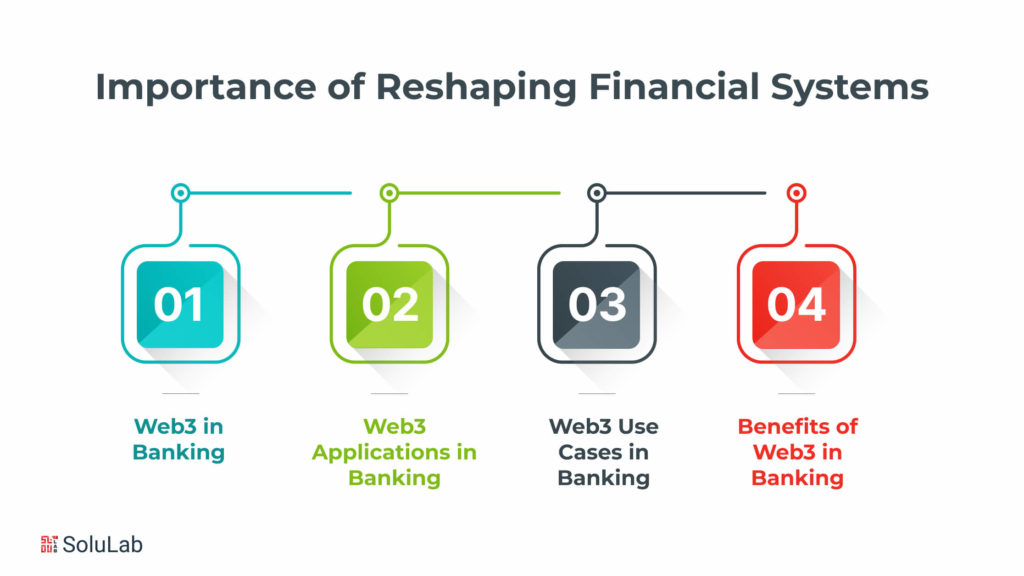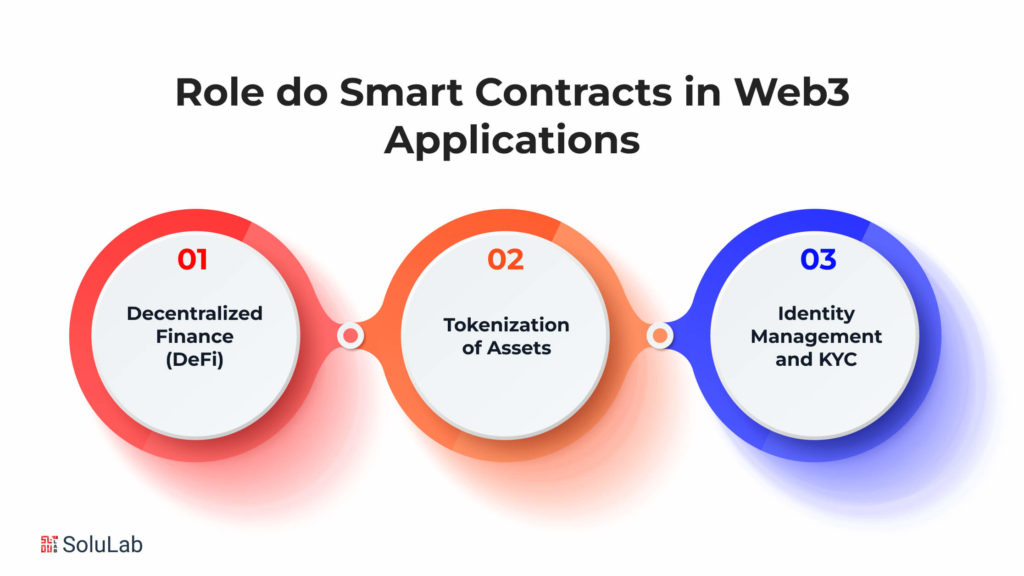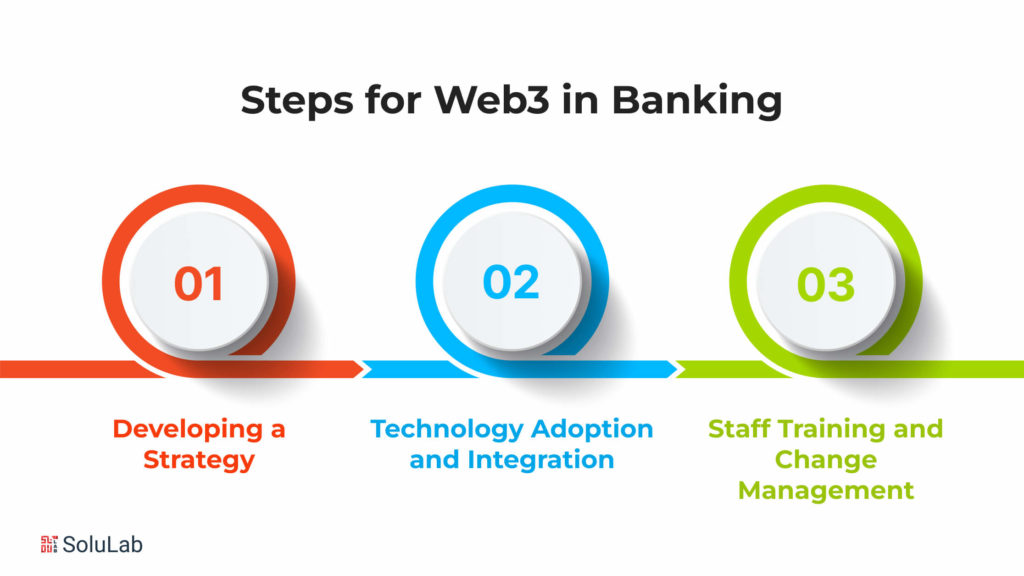
In the ever-changing environment of technical innovation, the rise of Web3 has dramatically transformed the foundations of many businesses, including the banking sector. Web3, the name used to describe the third age of the World Wide Web, presents a decentralized and user-centric paradigm that alters old paradigms of interaction and commerce.
Web3 is built on the ideas of decentralization, transparency, and user empowerment, to redefine how people interact with digital platforms. Unlike its predecessors, Web1 and Web2, which were centralized and controlled by a few individuals, Web3 uses blockchain technology and decentralized protocols to create a more open and inclusive digital environment.
Significant milestones in the growth of banking technology have occurred, ranging from Internet banking to the incorporation of artificial intelligence. Now, with the introduction of Web3, the banking sector is prepared for another transformational shift. Web3 in banking represents a shift away from traditional, centralized banking systems and toward a more democratic and interoperable financial environment.
The combination of Web3 with financial operations brings new concepts like decentralized ledgers, smart contracts, and tokenization. This combination of technologies promotes a more safe, transparent, and efficient financial environment. Financial transactions and interactions done on Web3 platforms are distinguished by fewer middlemen, higher security, and greater user control.
What is the Importance of Reshaping Financial Systems?

Web3 profoundly impacts reshaping financial systems, introducing unprecedented levels of transparency, security, and inclusivity. In the banking sector, Web3 technologies are transforming traditional processes.
-
Web3 in Banking
The incorporation of blockchain and decentralized technologies in banking systems creates Web3 banking. This evolution enhances security, reduces fraud, and provides users with greater control over their financial assets.
-
Web3 Applications in Banking
The applications of Web3 in banking are diverse, ranging from decentralized lending platforms and tokenized assets to cross-border payments facilitated by blockchain. These applications streamline processes and enhance financial inclusivity.
-
Web3 Use Cases in Banking
Use cases in Web3 banking include identity verification, transparent and traceable transactions, and decentralized finance (DeFi) trends. These use cases leverage blockchain’s capabilities to create a more efficient and secure financial ecosystem.
-
Benefits of Web3 in Banking
The benefits of Web3 in banking are evident in increased security, reduced costs, enhanced user control, and improved accessibility. These advantages contribute to a more resilient and user-centric financial system.
What are the Impacts of Traditional Banking?
The advent of Web3 technologies has ushered in a new era for the financial industry, reshaping the landscape of traditional banking in profound ways. This transformative wave brings forth a myriad of impacts, each contributing to the evolution of the sector. Here, we delve into key aspects that define the influence of Web3 on traditional banking.
-
Disintermediation and Decentralization
Web3 in banking marks a departure from the traditional intermediaries and centralized structures. The implementation of blockchain technology, a cornerstone of Web3, facilitates disintermediation by creating decentralized financial systems.
This shift empowers users, allowing for peer-to-peer transactions and reducing dependence on traditional banking intermediaries. As a result, the financial ecosystem becomes more inclusive, offering services beyond the confines of conventional institutions.
-
Smart Contracts and Automation
Smart contracts, enabled by Web3, introduce a new level of efficiency and automation in banking processes. These self-executing contracts are encoded with predefined rules, automating various functions such as loan approvals, fund transfers, and compliance checks.
This not only streamlines operations but also minimizes the risk of errors and fraud. The infusion of automation through Web3 technologies enhances the overall agility and responsiveness of traditional banking systems.
-
Enhanced Security and Transparency
Web3 in banking bolsters security measures through the implementation of advanced cryptographic techniques. Blockchain, a foundational component of Web3, ensures data integrity and immutability, making it extremely challenging for malicious actors to compromise information.
Moreover, the transparent nature of blockchain fosters a higher level of trust between stakeholders. Clients can trace transactions in real-time, providing unparalleled transparency in financial operations. This enhanced security and transparency contribute to the overall resilience of the banking ecosystem.
-
Web3 Applications in Banking
The integration of Web3 applications in banking brings forth a host of innovative solutions. These applications leverage decentralized technologies to offer services such as decentralized finance (DeFi), tokenization of assets, and decentralized identity verification.
Web3’s influence in banking is not confined to traditional structures, as it opens up avenues for financial inclusion and accessibility.
-
Web3 Use Cases in Banking
Web3 in banking manifests in various practical use cases, ranging from cross-border payments to decentralized lending platforms.
The utilization of blockchain technology enhances the speed and security of cross-border transactions, while decentralized lending platforms provide individuals with alternative sources of funding, bypassing traditional banking channels. These use cases underscore the versatility and potential of Web3 in transforming banking operations.
What Role do Smart Contracts Play in the Seamless Execution of Financial Transactions within Web3 Applications in Banking?

In the ever-evolving landscape of banking, the integration of Web3 applications has emerged as a transformative force, ushering in a new era of decentralization, transparency, and efficiency. This paradigm shift is marked by the adoption of decentralized finance (DeFi), tokenization of assets, and advanced identity management systems with Know Your Customer (KYC) protocols. Let’s explore the multifaceted impact of Web3 applications on the banking sector and delve into the myriad benefits and use cases.
A. Decentralized Finance (DeFi)
-
Decentralization Redefined
Web3 applications in banking leverage blockchain technology to create decentralized financial ecosystems. This not only eliminates the need for intermediaries but also ensures that financial transactions occur directly between peers, promoting trust and transparency.
-
Smart Contracts for Seamless Transactions
Smart contracts, a cornerstone of Web3, facilitate automated and secure financial agreements without the need for intermediaries. This ensures that transactions are executed seamlessly, reducing the risk of fraud and lowering operational costs for banks.
-
Liquidity Pools and Yield Farming
DeFi platforms built on Web3 enable the creation of liquidity pools, allowing users to contribute funds and earn interest. Yield farming, another DeFi development, incentivizes users to lock their assets into protocols, further enhancing liquidity and expanding the financial services landscape.
B. Tokenization of Assets
-
Fractional Ownership through Tokens
Web3 applications introduce the concept of tokenization, enabling the fractional ownership of traditionally illiquid assets like real estate or art. This democratizes investment opportunities, allowing individuals to invest in high-value assets with smaller amounts of capital.
-
Efficient Asset Transfer
Tokenization on Web3 facilitates the seamless transfer of assets. With assets represented as digital tokens on a blockchain, the process of buying, selling, and transferring ownership becomes highly efficient, reducing settlement times and associated costs.
-
Enhanced Liquidity and Market Accessibility
Tokenization increases the liquidity of assets by making them tradable 24/7 on decentralized exchanges. This broader market accessibility benefits both investors and banks, providing a wider pool of potential assets to manage and trade.
C. Identity Management and KYC
-
Decentralized Identity Solutions
Web3 applications in banking prioritize user privacy through decentralized identity management solutions. This ensures that individuals have control over their personal information, reducing the risk of identity theft and unauthorized access.
-
Streamlined KYC Processes
Web3 technologies enhance KYC processes by allowing users to share their identity credentials securely. This not only expedites onboarding but also ensures compliance with regulatory requirements, ultimately fostering a more secure and transparent banking environment.
-
Cross-Border Identity Verification
Web3 facilitates cross-border identity verification, enabling banks to collaborate seamlessly while ensuring the security of user information. This interoperability reduces friction in international transactions and enhances the efficiency of global banking operations.
Read Also: Build MiCA-Compliant Neo Banks in Europe
What Regulatory Challenges do Traditional Banks Face as they Integrate Web3 Technologies into their Financial Operations?
As the financial industry undergoes a transformative journey with the integration of Web3 technologies, several challenges and concerns have emerged. This article delves into the key hurdles faced by banks venturing into the realm of Web3 in finance, shedding light on regulatory obstacles, security risks, and integration challenges.
-
Regulatory Hurdles
The adoption of Web3 applications in banking introduces a complex regulatory landscape that traditional financial institutions must navigate. The decentralized nature of Web3 challenges existing frameworks designed for centralized systems, leaving regulators grappling with the need to adapt.
Key concerns include issues of jurisdiction, compliance, and the establishment of a regulatory framework that accommodates the dynamic and distributed nature of Web3 banking.
-
Security Risks and Mitigations
Web3 banking brings forth heightened security risks, primarily due to the decentralized and open-source nature of blockchain technologies.
Smart contracts, a fundamental component of Web3 applications, can be vulnerable to exploitation if not properly audited. Traditional banks stepping into the Web3 space must prioritize robust cybersecurity measures, conduct thorough code audits, and implement mitigation strategies to counter potential threats, ensuring the integrity and confidentiality of financial transactions.
-
Integration Challenges for Traditional Banks
Integrating Web3 technologies into the existing infrastructure of traditional banks poses a substantial challenge. Legacy systems may struggle to adapt to the decentralized and trustless nature of blockchain, hindering seamless integration.
Banks need to invest in training their workforce to understand and navigate the complexities of Web3 applications. Additionally, there is a need for a phased approach to integration to minimize disruptions to existing services while embracing the benefits of Web3 in banking.
Web3 applications in banking are revolutionizing the industry by enabling trustless and transparent financial transactions. From decentralized finance (DeFi) platforms to blockchain-based identity verification, the use cases for Web3 in finance are diverse and expansive.
How do Web3 Technologies Contribute to the Unlocking of Global Financial Inclusion?
In the rapidly evolving landscape of global finance, opportunities for financial inclusion have expanded exponentially, primarily driven by the integration of innovative technologies. One such groundbreaking advancement is the emergence of Web3 technologies, which are reshaping the way financial services are accessed and delivered. In this article, we delve into the multifaceted opportunities that Web3 brings to the forefront of financial inclusion.
-
Access to Financial Services Globally
Web3 technologies are proving to be instrumental in breaking down geographical barriers and providing unprecedented access to financial services on a global scale. Traditional banking systems have long struggled to reach remote and underserved communities, leaving billions unbanked.
However, the decentralized nature of Web3, facilitated by blockchain technology, allows for the creation of borderless financial networks. Through the use of cryptocurrencies and decentralized finance (DeFi) platforms, individuals anywhere in the world can access a wide array of financial services without the need for a traditional bank account.
Moreover, the transparency and security features embedded in Web3 applications enhance trust, encouraging greater participation from individuals who were previously excluded from the formal financial sector. As a result, Web3 technologies are fostering financial inclusion by providing a level playing field for all, irrespective of their geographical location or socioeconomic status.
-
Empowering the Unbanked through Web3 Technologies
A significant portion of the global population remains unbanked or underbanked, facing barriers to entry into the traditional financial system. Web3 technologies are emerging as a powerful force in addressing this issue by leveraging blockchain to create decentralized financial ecosystems.
Through the use of Web3 applications in banking, individuals without access to traditional banking services can now participate in financial activities, such as borrowing, lending, and even earning interest through decentralized platforms.
The concept of “Web3 banking” signifies a shift towards user-centric financial services, where individuals have greater control over their assets and financial decisions. This empowerment of the unbanked is not only a testament to the potential of Web3 technologies but also a key driver in reducing global economic disparities.
-
Case Studies and Success Stories
Numerous case studies and success stories illustrate the transformative impact of Web3 technologies on financial inclusion. For instance, in regions where traditional banking infrastructure is scarce, decentralized finance platforms built on Web3 principles have enabled individuals to access loans, invest in assets, and engage in economic activities seamlessly.
Web3 use cases in banking are diverse, ranging from peer-to-peer lending platforms to decentralized identity solutions that enhance financial accessibility.
These success stories underscore the adaptability and resilience of Web3 technologies in creating tangible, positive outcomes for individuals and communities.
What are the Steps essential for Web3 in Banking?

In the rapidly evolving landscape of finance, the integration of Web3 technologies has become imperative for banks aiming to stay ahead of the curve. Web3, a decentralized and trustless paradigm, is reshaping traditional banking structures. To seamlessly embrace Web3 in banking, organizations need to follow a strategic approach, emphasizing technology adoption, integration, and comprehensive staff training. Here’s a step-by-step guide to navigating this transformative journey:
A. Developing a Strategy
The first and foremost step towards Web3 integration in banking involves developing a robust strategy. This includes understanding the nuances of Web3 in finance and identifying potential use cases in the banking sector. Institutions must assess their current infrastructure and identify areas where Web3 use case can enhance efficiency, security, and transparency.
Key Considerations
- Conduct a thorough analysis of Web3 use cases in banking.
- Define clear objectives and goals for Web3 integration.
- Establish a dedicated team to oversee the strategy implementation.
- Ensure alignment with regulatory requirements and compliance standards.
B. Technology Adoption and Integration
Once a comprehensive strategy is in place, the focus shifts to the adoption and integration of Web3 technologies. This step involves identifying suitable platforms and tools that align with the defined strategy. Web3 applications in banking may include blockchain-based solutions, smart contracts, and decentralized finance (DeFi) protocols.
Key Steps
- Evaluate blockchain platforms suitable for banking applications.
- Integrate smart contract functionalities for automated and secure transactions.
- Explore decentralized finance solutions for enhanced financial services.
- Collaborate with FinTech partners specializing in Web3 technologies.
C. Staff Training and Change Management
Successful Web3 integration in banking is not just about technology—it’s also about people. Staff training and change management are critical components to ensure a smooth transition. Banking professionals need to understand the principles of Web3, its impact on traditional banking processes, and how to leverage new technologies effectively.
Training Essentials
- Conduct workshops and training sessions on Web3 fundamentals.
- Foster a culture of adaptability and continuous learning.
- Provide resources and support for employees to upskill in relevant areas.
- Implement a phased approach to ease the transition and minimize disruption.
By following these steps, banks can position themselves at the forefront of the Web3 revolution, unlocking new opportunities for innovation and customer satisfaction. Embracing Web3 in banking is not just a technological upgrade; it’s a strategic transformation that redefines the way financial institutions operate in the digital age.
Conclusion
Finally, SoluLab’s complete reference to Web3 in banking demonstrates the transformational power of decentralized technology in the financial industry. SoluLab, a major Web3 development firm, underlines the importance of Web3 applications in banking and provides a roadmap for institutions to reap the benefits of this unique paradigm shift.
The tutorial digs into the numerous applications of Web3 in finance, demonstrating its ability to improve security, transparency, and efficiency in financial processes. For firms wishing to stay ahead in the digital market, hiring Web3 developers is recommended, highlighting the importance of competence in negotiating the complexity of Web3 banking.
SoluLab’s ability to navigate the difficulties of Web3 in the banking industry distinguishes it as a trustworthy partner for financial organizations looking to stay ahead in the age of decentralized finance. SoluLab leverages the power of web3 finance to not only allow seamless transitions but also open up new options for growth, innovation, and sustainable development in the banking industry.
FAQs
1. What is Web3 in the context of banking and finance?
Web3 in banking refers to the third generation of the internet, emphasizing decentralized, trustless systems. In finance, it introduces a paradigm shift towards decentralized applications (dApps) and blockchain technology to enhance security and transparency.
2. How does Web3 impact traditional banking structures?
Web3 in banking disrupts traditional structures by reducing reliance on intermediaries, fostering peer-to-peer transactions through smart contracts, and enabling financial services without the need for a central authority.
3. What are the key Web3 applications in banking?
Web3 applications in banking include decentralized finance (DeFi) platforms, smart contracts for automated transactions, blockchain-based identity verification, and tokenization of assets, providing efficient and secure financial services.
4. Can you elaborate on Web3 use cases in banking?
Web3 use cases in banking encompass a wide range, from cross-border payments and remittances facilitated by blockchain to transparent and automated lending through smart contracts. Tokenized assets also enable fractional ownership, expanding investment opportunities.
5. How does Web3 enhance security in banking transactions?
Web3 employs cryptographic principles and decentralized consensus mechanisms, such as blockchain, to ensure secure and tamper-resistant transactions. This mitigates risks associated with fraud, identity theft, and hacking prevalent in traditional banking.
6. What role does decentralization play in Web3 banking?
Decentralization in Web3 banking eliminates the need for a central authority, empowering users with control over their assets and data. This shift fosters financial inclusivity and reduces the risk of single points of failure.






